Witness Tells of Detention of Cham at Wat O Trakuon
Today, witness Muy Vanny gave his testimony before the Trial Chamber in Case 002/02. He was the bodyguard and messenger of Kang Meas district security chief Horn and spent, in this function, some time at Wat O Trakuon – a Security Center where allegedly 30,000 people were killed. He told the Court that the Cham people in his district were killed.
Function of the witness
At the beginning of the session, the Trial Chamber President Nil Nonn announced that witness 2-TCW-987 would be heard. The Trial Chamber Greffier then announced the presence of all parties with Nuon Chea following the proceedings from the holding cell.
Due to technical difficulties with the translation outputs, the session was delayed for twenty minutes. After the technical issues were resolved, the court resumed at 9.40 am. The Trial Chamber Greffier announced that the witness was present in the court room and that witness 2-TCW-988 was on the reserve.
Witness Muy Vanny was born on June 7 1967. He was born in Anlong Ak Village, Kang Meas District, Kampong Cham Province. He is a primary school teacher. His wife is deceased and he has one child.
The floor was granted to the Co-Prosecutors. International Senior Assistant Prosecutor Vincent de Wilde asked to clarify the birth date. The witness replied that this was the date of his birth on his ID card. Mr. Vanny confirmed that this was the correct date. He could not recall his exact age at the time of the Khmer Rouge, but he was “pretty young” he said. Mr. de Wilde asked for further clarification, since he had indicated different ages, ranging from 9 years old to 11, 14 or 15 years old.[1] According to his ID card, he was 11 years old back then. The witness replied that it was his estimate that he was around 11 or 12 years old back then.
Mr. de Wilde asked whether he remembered what year his birth village was occupied. Mr. Vanny could not remember. He lived in a children mobile unit in the village. There were problems when he was there, “as I took rice from the children unit to my home.” He was reassigned to a mobile unit for adults by the unit chief. The age range was between 20 and 30 years old in this new unit. He confirmed that he was the youngest member in this unit. He was initially assigned to a unit in the commune, but later to a district mobile unit. Mr. de Wilde then inquired whether he ever worked in Sdao Commune, which Mr. Vanny confirmed. He could not recall how many months he worked at the district mobile unit. He said that he worked at Wat O Trakuon Pagoda for around two years. Mr. de Wilde inquired whether he was sure about this. “Was that the time that you were working for Horn?” Mr. Vanny confirmed that he worked as a body guard for Horn. “I usually accompanied him when he went to visit soldiers within the district.”
Mr. de Wilde referred to his Written Record of Interview: he had said that he had worked with Horn for five to six months and then the Khmer Rouge regime collapsed.[2] The witness said that he worked with Horn for a long period of time.
He usually stayed with soldiers and did not stay at Wat O Trakuon. Mr. de Wilde asked whether he referred to soldiers that were stationed in the district or to those who were located at Wat O Trakuon. He replied that he referred to soldiers from the commune level.
Mr. de Wilde then asked where Horn’s office was located and what his duties and responsibilities were. He had his office at Wat O Trakuon, which was a Security Center. Horn was chief of security of Kang Meas District. He was also chief of soldiers at the district level. The forces for the district mobile unit were composed of forces from the communes that were under the district.
Mr. de Wilde then asked who the chief of his unit was. When the witness could not remember, Mr. de Wilde referred to his Written Record of Interview, in which he had mentioned someone called Chhun.[3] The witness confirmed that this refreshed his memory that Chhun was the chief. Mr. de Wilde then wanted to know how many people were in his unit. He replied that there were around 30 people in his unit. He could not recall how many Cham there were in his unit, albeit he could remember that there were some. This prompted Mr. de Wilde to quote his answer, in which he had said that 25 of the 30 people in his unit were Cham. He said that this was “about right”, but he did not know the exact number. He confirmed that there was a large number of Cham in his unit. They could identify them by the way they spoke. Mr. de Wilde asked whether they could also identify them by their names, which the witness confirmed. They also asked about their background, since they worked together closely. “And later on, the Cham people, all of them, were taken away.” He further recalled that: “By the time we knew the Cham were targeted and taken away to be killed.” The Khmer people were not taken away.
Arrests and executions of Cham
Many Cham were living in Peam Chi Kang Commune; some Cham people were living in Sach Sau. The Cham only spoke Khmer, but this with an accent. “They did not dare speak their Cham language.” They were prohibited from practicing their religion, speak their language or wear their traditional attires.
Mr. de Wilde asked whether he ever heard any cadre saying that there were no minorities anymore and only “one people.” The witness replied that he did not pay attention to this matter, but no one spoke any other language beside Khmer.
Mr. de Wilde then inquired what happened to the Cham in his district mobile unit. Mr. Vanny replied that he was with the members of his unit clearing grass far away from their sleeping quarter. “I saw them being tied up and walked away while I was returning to my sleeping quarter on an oxcart”. He could only identify a few of them, since it was dark. They were lined up. When he returned to his sleeping quarter, only the Khmer people were left of his unit. It was his understanding that they knew who was Cham and who was Khmer and took away the Cham people. This took place in Sdao Commune. He did not count the Khmer people who remained.
Mr. de Wilde asked whether he knew what happened to the relatives of the members of the mobile unit who were taken away. Mr. Vanny replied that he did not know at the time. He did not know “whether the parents had been sent away first” or whether the children had been arrested first, or both at the same time. He did not learn anything about this later. They were living in different houses, far away from each other. “At the time I did not know what happened to those Cham men.” He did not know whether there had been other arrests.
He witnessed those people midway on his way back home when he was on an oxcart. His village was quiet and people told him that the Cham people had been arrested. He therefore did not witness whether there was any resistance when they were arrested. He did not know the people who arrested the Cham. “I did not know where they were from. I did not dare to poke into their business”.
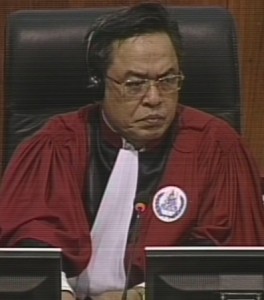
Trial Chamber President Nil Nonn
Mr. de Wilde inquired whether he could recall that they were security agents or militiamen, as he had indicated in answer 73.[4] He replied that they may have been security guards or militiamen, but he “was not interested in their origin”. Mr. de Wilde asked whether he was able to recognize those people later when he worked at Wat O Trakuon later. He replied that he could still recognize one person of the name Poan.
In his Written Record of Interview, he had said that they were tying up of Cham people.[5] Mr. de Wilde asked whether he saw the tying-up of the Cham people, which the witness denied. He recognized one or two of the people who were tied up and walked away. He did not know what had happened to them before they were being walked away.
He did not know about lists of Cham people that had been drawn up before. The unit chiefs would have known the matter, he said, but not him. A few days later, he heard that those people had been killed. “But I did not know where they had been killed. Some people said they had been killed at Sdao Pagoda.” He was scared that he “would be one amongst them.”
Mr. de Wilde asked about his Written Record of Interview, in which he had said that the Khmer Rouge gathered all of the Cham people and slaughtered them at Wat O Trakuon.[6] Mr. de Wilde inquired whether he obtained any information later that the Cham people were “slaughtered at Wat O Trakuon” pagoda as he had indicated in his Written Record of Interview. Mr. Vanny replied that he did not know about this matter. Mr. de Wilde referred to his interview, in which he had said that they had told him the next day that they were taken to Wat O Trakuon. He replied that he “was not able to know” where they had been taken to. Three or four days later “people whispered” that these people may have been killed at Sdao Pagoda.
At this point, the President interrupted the questioning and adjourned the hearing for a break.
Wat O Trakuon
After a short break of ten minutes, Mr. de Wilde resumed his questioning. He asked whether he ever saw those Cham again that had been arrested. He replied that they disappeared. Mr. de Wilde wanted to know whether he had heard about arrests of other Cham in the same district but at other locations. He replied that he did not know, since he could not walk freely. It was his understanding that people were arrested in several locations in the same commune.
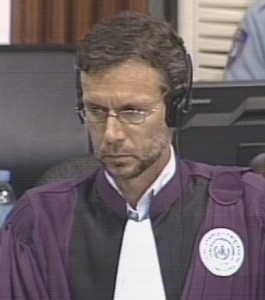
International Senior Assistant Prosecutor Vincent de Wilde
Mr. de Wilde asked whether any Cham person survived the Democratic Kampuchea regime in Kang Meas district. Nuon Chea Defense Counsel Victor Koppe objected and said that the witness had no way of knowing this. Moreover, the witness was only 11 years old at the time. Mr. de Wilde said that he only wanted to know whether he knew of any Cham person who survived. The objection was overruled. He replied that a husband and a wife survived who hid in a pond in a forest. “Only after the fall of the regime I learned of their survival.” They were from Sach Sau in Peam Chi Kang commune. He did not hear of any other survivals.
Mr. de Wilde turned to Wat O Trakuon during the time that Mr. Vanny worked there as a bodyguard of Horn. Mr. de Wilde asked what level Wat O Trakuon belonged to. Mr. Vanny replied that it was part of the district security. Wat O Trakuon was around two kilometers away from the district office. Wat O Trakuon Pagoda was located in Sambuor Meas Village. He did not know why he was selected to work at Wat O Trakuon. His unit chief was called later that they had to stay at Wat O Trakuon Pagoda. “I was rather shocked, because we heard that Wat O Trakuon was a killing site.” The other guards were “much older” than him, some of them being 30 or 40 years old. There were no other adolescents of 16 or 17 years old. He was on rotation with another guard. Sometimes he remained with the other soldiers while Horn went to inspect the other soldiers. “It was [Horn’s] own discretion”. He also fulfilled a function of a messenger. Mr. de Wilde wanted to know whether Horn entrusted him with letters to be delivered within the district or other communes with Kang Meas District, which the witness denied. “That never happened.”
Mr. de Wilde asked what his role of being a bodyguard and a messenger entailed. The witness explained that “when you refer to the role of the messenger, you also refer to the role of a bodyguard.” He would sometimes bring letters to the communes, but never to the district. Horn gave him these letters.
Mr. de Wilde read out an excerpt of the OCP Interview notes of another witness, who was a former monk at Wat O Trakuon and who had said that Mr. Vanny was a messenger of the office and not only of Horn.[7] Mr. de Wilde asked whether he could transmit letters even when Horn was not stationed there. He replied that he would only deliver messages when he was asked to do so. The former monk had indicated that Mr. Vanny was 16 or 17 at the time. He replied that this person may have confused his age. He did not know where Horn came from, but he heard people say that he came from the Southwest Zone.
He was armed with an AK-rifle. “Later on, because of its heavy weight, and actually when I was carrying the AK-rifle, I had a swollen arm.” He requested to have another kind of rifle. The other soldiers were also armed. Sometimes they swapped the rifles. Mr. de Wilde asked whether he understood it correctly that everyone in the pagoda was armed with small guns or AK rifles. There was another group that carried long swords. This group was stationed within the premise of the pagoda. When asked who was responsible when Horn was not there, he replied that there was Kuong, who was replaced by Bot when Kuong was executed. This prompted Mr. de Wilde to refer to the witness interview, in which he had indicated that Bot died and Kuong became Horn’s assistance.[8] Mr. Vanny confirmed that Bot preceded the other person. The witness could move within the Wat O Trakuon pagoda, but since he was young, he was afraid to move within the premises.
Mr. de Wilde asked what his daily duties were when he did not have to accompany Horn. He explained that he did not engage in any other duties. He would rest when he did not accompany him. Sometimes he would “stand and chat with light offence prisoners.” Sometimes he would pick fruits.
“So I was rather curious what was happening on the ground”, so he would look around sometimes. “I saw people being chained, shackled, within the main temple. Their ankles were shackled.” The prisoners were given gruel mixed with morning glory or mixed with yam. They were given half of a coconut full of gruel.
The superior of Horn was district chief Kan. He was also from the Southwest group. People said that all district and commune chiefs were from the Southwest.
Other cadres
After the lunch break, the floor was given to the Co-Prosecution. Mr. de Wilde asked whether Horn reported to and received orders from Kan. The witness replied that he was not aware of that issue. Mr. de Wilde then asked whether Kan came to the pagoda, his office having been only two kilometers away from the pagoda, to hold meetings. Mr. Vanny replied that he never saw him. Mr. de Wilde then asked whether there was also a group of people with long swords at Peam Chi Kang commune, which the witness did not know. Mr. de Wilde then asked whether the guards at Wat O Trakuon belonged to the district. Mr. Vanny replied that only “colleagues” were allowed to enter the pagoda. Mr. de Wilde clarified that he was asking whether they belonged to the commune or district. He replied that Kan was the district chief. He did not notice the presence of any security guards in the pagoda.
Arrests
Mr. de Wilde then asked whether the people carried out arrests within Kang Meas. He answered that he “was in the location for a brief period of time. I only noticed that people were transported into that pagoda. I did not know whether these people were arrested by the security guards.”
Mr. de Wilde said that Mr. Vanny had mentioned three names in his Written Record of Interview: Koung, Moeun and Hun.[9] Mr. de Wilde asked to confirm that these three people were working within Wat O Trakuon Pagoda, which the witness confirmed. Sometimes, militiamen would transport those people into the pagoda by oxcart. He would see a group of two or three people being sent into the Security Center Wat O Trakuon. They would hand over the people at the entrance of the compound at the pagoda.
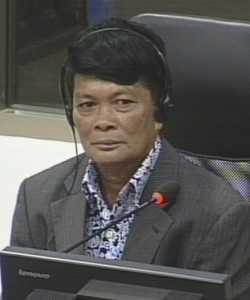
Witness Muy Vanny
Mr. de Wilde then wanted to know whether Mr. Vanny ever witnessed arrests while being the bodyguard of Horn. He replied that he never saw this. “I did not know about the issue. He only saw the people within the pagoda. “Horn himself never went out to make the arrests.” This prompted Mr. de Wilde to refer to Mr. Vanny’s Written Record of Interview. He had talked about the arrests of people that he had witnessed and that Horn had carried out.[10] The witness insisted that he had never seen this. Usually, he said, the senior people would not carry out arrests themselves. He did see that Cham people were sent to the pagoda while working at Wat O Trakuon. He also saw them right in front of the pagoda. They mostly came by oxcarts. There were some people who arrived by boat. Sometimes, there were many of them and sometimes only a few.
Mr. de Wilde wanted to know how many people were brought in at the same time when there were “many.”Mr. Vanny replied that it might have been fifty or hundred people arriving if they came by boat. He had heard that there was a plan to round up Cham people, but he did not know whether this actually happened. Cham people were a majority at the pagoda. “There were not so many Khmer people.” Other groups of Cham might have been taken to the pagoda, “to satisfy the cooperative.”
Mr. de Wilde then inquired whether the guards checked whether the people were indeed Cham or not at the entrance. Mr. Vanny recounted that he noticed people coming in, but he did not know whether they were asked initial questions.
Mr. de Wilde then turned to the Khmer prisoners and asked what happened to those who were accused of committing serious offenses; were they interrogated? Mr. Vanny replied that some people were sent out to interrogate. The school was used as an interrogation place and remained until today.
Mr. de Wilde inquired whether, in contrast, the Cham people were not interrogated. Mr. Koppe objected to the question and said that this was a leading question, pointing towards the use of the words “in contrast.”
Mr. de Wilde rephrased his question and asked hwether Cham people were interrogated. The witness replied that they did not interrogate the Cham people. They would not interrogate the arrestee, “unless there was an issue.” Sometimes, it happened that one or two went down to conduct the interrogation. He did not know why they did this. Mr. de Wilde referred to the witness’s interview: he had said that the Cham were not interrogated but executed three or four days later.[11] Mr. de Wilde asked whether Mr. Vanny knew why the guards did not go through “the trouble” to interrogate the Cham, which the witness could not answer.
Khieu Samphan Defense Counsel Anta Guissé objected and said that the testimony he had given today conflicted with what he had said before. Mr. de Wilde asked whether the Cham were interrogated. Mr. Vanny replied that they were not interrogated.
He confirmed that all Cham people were executed. He replied that they were executed and in the morning they would not return. He did not know at what time these people the people were killed. They were killed around a hundred meters away from the pagoda, a location which was used to plant mango trees.
Sometimes, the seniors assigned him to “take the water” and he was terrified and “almost cried” when he saw something. When Mr. de Wilde inquired when he saw these executions, Mr. Koppe objected and said that the witness had not clearly said that he saw executions.
Mr. de Wilde asked the question again. He replied that he did not go to the place itself, since it was terrifying, “because hundred people I saw, but immediately they disappear and I did not know what happened to them.”
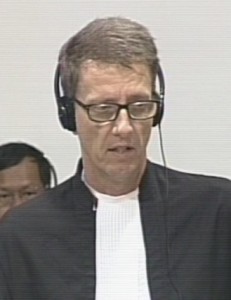
International Nuon Chea Defense Counsel Victor Koppe
Mr. Koppe objected when Mr. de Wilde asked whether he witnessed the executions, and said “it is leading all along, all the way.”
Mr. de Wilde referred to the witness’s statement. He had confirmed that he saw killings (two or three times) and had described executions.[12] Mr. Koppe said that this question was “completely leading” and that any following answer was worthless. The objection was overruled. The question was repeated. The witness replied that he did not see executions. “I just only brought the water to the people.”Mr. de Wilde asked how he knew all the details he had given about the executions and whether someone had told him so. Mr. Koppe objected again, saying that the Prosecutor should stop leading the witness: “it’s unbelievable.” The objection was overruled.
The witness replied that he had been told that the people were killed. “In terms of how these people were killed, it was really scary to me.” Asked about the number of people, he said that he did not know, since he was not in charge of statistics. However, there were around 30,000 of dead people there. He never returned to that location afterwards. “There is no point for me to go there, and besides I lived far away from that location.” The site turned into a plantation.
With this, International Senior Assistant Prosecutor Vincent de Wilde finished his line of questioning.
National Civil Party Lead Co-Lawyer Pich Ang put the first question to Mr. Vanny and asked to clarify the issue of fetching the water. He replied that he was asked to bring water when he saw the people who were tied up.
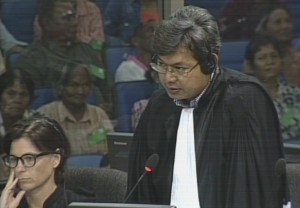
National Civil Party Lead Co-Lawyer Pich Ang
There were not many people who were tied up. He could not estimate the number of detainees “since I did not see it clearly.” Mr. Ang asked to clarify how many people were tied up. He replied that there were “a few” who were tied up and sent away. Pressed on this matter, he said that there were two or three victims. Asked again, he said that he saw around ten people who were sent away to be executed each time. He clarified that he misunderstood the question as referring to the number of people who tied them up, and not those who were tied up. He witnessed this one time when he was asked to bring them the water to “where they would let those people out.”
He was unable to tell the court how many people were in the main hall. “I only saw that the hall was full of people.”It was a “standard” main hall. “As I said a while ago, there was a plan to exterminate all Cham people”. He had heard about this from survivors after the regime.
Mr. Ang wanted to know how he knew that the majority were Cham. He replied that he asked those who worked in the kitchen hall whether they were Cham.
He did not know the individual roles of some people. He only knew the role of Horn and his deputies Kuong and Bot. The pagoda was under Kuong’s authority when the people were brought away. There were around ten workers in the premises of the pagoda. He recalled the name of Moeun.
He had talked about a friend who had asked for help. Mr. Vanny said that he asked for help when the friend saw him. His friend was Khmer.
Mr. Ang then wanted to know who told him about the plan to gather up the Cham. He replied that it was someone who worked at the pagoda, but it was a long time ago. He was asked to bring water when the people were walked out at around 7 pm. With this, the Civil Party Lead Co-Lawyer finished his line of questioning.
Clarifying questions by Judge Lavergne
After the last break, the floor was granted to Judge Jean-Marc Lavergne, who asked until when the witness exactly the witness worked at Wat O Trakuon. He did not know when exactly he worked there. He worked there, however, until the fall of the Khmer Rouge regime – when the Vietnamese entered. He did not know whether there were still prisoners there at this time, since he “ran back home.”
He only knew the location where the people were interrogated, but did not know about the interrogation itself. They executed people outside the compound of the pagoda. He said he would be able to show the Court where exactly the location was if they visited the pagoda. He did not see the execution during the regime, but he knew of it at present time.
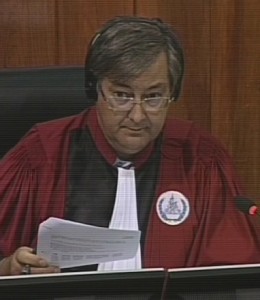
Judge Jean-Marc Lavergne
He had said in his interview that he went to the interrogation or execution site with the chief.[13] Judge Lavergne asked whether he remembered having made this testimony and whether this testimony remained true. The witness replied that he had not been in a position to visit the location. He had noticed that people were detained for a few days and then taken away. “Personally, I did not walk to that place.” He was young and scared to go there; “I was also afraid of ghosts.” He was asked to bring water to the monk’s residence. He was asked to bring the water to the deputy chief. He returned after having left the water there. He would usually watch the chief’s residence when the chief was not present. He saw people being tied up and “let out”. He saw prisoners in front of the main hall. He was not allowed to enter the main hall. They partitioned the hall where the female prisoners were. There was a window in the hall where he could look into the hall.
He did not know whether the exact number of people who were killed there were 30,000, but there was a stupa with many skeleton remain.
As for the mango plantation that he had mentioned earlier, he said that the plantation remained until today. They also planted banana trees. When he saw the plantations, there were some old banana trees.
Judge Lavergne then asked whether he knew Angkor Ban commune, which the witness confirmed. He knew the cadre who was responsible for Angkor Ban, but did not know where this person went. His name was Kuong.
Judge Lavergne then referred to the testimony of witness Seng Srun, who talked of Run, who was chief of security at Angkor Ban.[14] The witness replied that this name did not “ring a bell”. Judge Lavergne wanted to know whether he ever attended a meeting chaired by Kan, the chief of security, or Horn, which the witness denied.
Duties of Mr. Vanny
Next, Nuon Chea Defense Counsel Victor Koppe put questions to the witness. He started by inquiring about the date of birth. The witness said that his teacher gave him this date of birth when he wanted to enroll as a public servant. He did not know whether his teacher had any facts to base himself upon. He confirmed that there was no misunderstanding and that he was born on June 07 1967.
Turning to his next topic, Mr. Koppe inquired whether it was the witness’s job to protect Horn, or whether his job was merely to fulfill small tasks. Mr. Vanny replied that he could be used for any task. There was no occasion where he had to actually protect Horn. The witness denied ever having had a military training. He was not trained how to use his AK-rifle. They were only trained later, but he never fired a single shot.
Mr. Koppe then asked how long Mr. Vanny worked for Horn. He estimated that he worked for him between five and six months. Mr. Koppe then asked whether it was correct that he was only at Wat O Trakuon, because Horn was there sometimes, which the witness confirmed. “When he went to O Trakuon, I would accompany him.”Mr. Koppe then asked how many nights the witness slept at Wat O Trakuon in total. The witness replied that he may have rested there for two nights or three nights. With this, he referred to individual occasions. Horn had a different house and would sleep there. Sometimes, Mr. Vanny would also sleep there. He could not shed much light on the matter.
Mr. Koppe moved on and asked whether he remembered talking about light offenders and serious offenders. Mr. Vanny replied that the light offenses could be for stealing something to eat. His younger brother was about to be arrested when the pig was digging in the soil and the sweet potato “came out of the ground.” He was “not so aware” of the distinction between light and serious offenders. To his knowledge, the people who were seen as offenders, were put into Wat O Trakuon for about one week. Some of the offenders at Wat O Trakuon had been stealing jackfruits.
Mr. Koppe asked whether the witness had ever heard who of the security people at Wat O Trakuon might have been involved in the execution of people. He had heard of people who were executioners, but they had all died. He had heard after the fall of the regime that Horn died already. Mr. Koppe then asked how the people in the kitchen could possibly know the backgrounds of the prisoners. He replied that he did not know when they were there. “I was quite young at the time and I sometimes chitchatted with others at that location.”
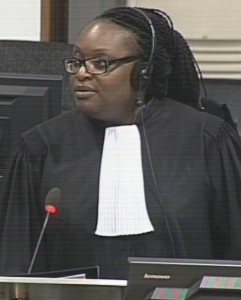
International Khieu Samphan Defense Counsel Anta Guissé
Turning to his last question, Mr. Koppe inquired about a possible sexual offense with someone involved who was called Bot. He replied that he learned about it from the chef of the kitchen house – from the cook of the long sword unit. The cook fell in love with a female person, who confided into the female cook. Bot was arrested. The deputy chief under Horn raped the female that he had just mentioned. When Horn learned about this, Bot and the woman were executed. She was considered the one who committed the offense. He did not witness the execution himself.
The floor was then granted to International Khieu Samphan Defense Counsel Anta Guissé. She asked whether she was right that her native village was Anlong Ak. She asked whether he flew to Anlong Ak when he heard about the arrival of the Vietnamese, which the witness confirmed. He learned that the Vietnamese were arriving when he was in Peam Chi Kang commune. He was not stationed at Wat O Trakuon at the time, since Horn ordered them to counter the Vietnamese attacks. He was still working with Horn.
Ms. Guissé then asked whether he remembered the children unit in the commune and when he started working there. He replied that he did not remember when he started working in this unit. He was part of the district mobile unit when he was working with the people who were 20 to 30 years old. She asked whether he referred to the people who were 20 to 30 people when he talked about arrests. He replied that they were youths. He said he was unable to tell her how old someone had to be to be considered youths. However, he confirmed that they were no children.
With this, Ms. Guissé finished her line of questioning.
The President adjourned the hearing, which will resume tomorrow, January 11 2016, at 9 am. The witness Muy Vanny will be heard first.
[1] E319/19.3.93 answer 3, and E319/19.3.2.19. [2] E19/19.3.93, question 38. [3] E319/19.3.93. answer 73. [4] Answer 73. [5] E319/19.3.93, at Answer 73 [6]Answer 93. [7] E3/7827, p.3 (en) p 2 (fr) p. 4 (kh); [8] Answer 59 E319/19.3.93, : [9] E319/19.3.93. [10] E319/19.3.93, at question and answer 17. [11] E319/19.3.93, at answer 79. [12] Ibid., question 35. [13] E319/19.3.93, question and answer 77. [14] Seng Srun’s testimony of 13 September 2015.
